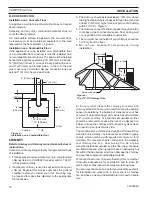
VSW40 Wood Stove
14
20300060
MAINTENANCE
CLEANING YOUR ChIMNEY
The Challenger VSW40 stove has a removable baffle which
allows the chimney to be cleaned without removing the
connector from the stove.
Make sure the stove is cool before
proceeding
To remove the rear of the baffle,
reach in through the door and lift
up on the rear half of the baffle and,
very carefully with your fingers, walk
the rear half of the baffle up and onto
the front half of the baffle. Make sure
you slide it far enough forward so
the chimney brush will not damage it
when cleaning.
Figure 11a.
There is
no need to remove the secondary air
tubes for cleaning.
After the chimney has been cleaned
clean out the firebox and carefully
replace the rear half of the baffle. Check to see that both
pieces of the baffle are down on the steel baffle and pushed
all the way to the rear of the firebox.
Figure 11b
CREOSOTE
When wood is burned slowly, it produces tar and other
organic vapors. These combine with moisture to form
creosote. Creosote vapors condense in the relatively cool
chimney flue of a slow burning fire. As a result, creosote
residue accumulates on the flue lining. When ignited,
this creosote makes an extremely hot fire. The chimney
should be inspected regularly during the heating season to
determine if a creosote build-up has accumulated. If this
is the case, the creosote should be removed to reduce the
risk of chimney fire.
WARNING:
Things to remember in case of chimney fire:
1. CLOSE dRAFT CONTROL
2. CALL ThE FIRE dEPARTMENT
kEEP UNIT FREE OF CREOSOTE
1. Burn with air control open for several minutes at
numerous intervals throughout the day during the
heating season, being careful not to over-fire unit. This
removes the slight film of creosote accumulated during
low burn periods.
2. Burn stove with draft control wide open for several
minutes every time you apply fresh wood. This allows
wood to achieve the charcoal stage faster and burns
wood vapors which might otherwise be deposited within
the systems.
3. BURN ONLY SEASONED WOOD. Avoid burning wet
or green wood. Seasoned wood has been dried for at
least one year.
4. A small hot fire is preferable to a large smoldering one
that can deposit creosote within the system.
5. Establish a routine for the fuel, wood burner and firing
technique. Check daily for creosote build-up until
experience shows how often you need to clean to be
safe. Be aware that the hotter the fire, the less creosote
is deposited and weekly cleaning may be necessary
in mild weather even though monthly cleaning may
be enough in the coldest months. Contact your local
municipal authority for information on how to handle a
chimney fire. Have a clearly understood plan to handle
a chimney fire.
ASh dISPOSAL
Ashes should be placed in a metal container with a tight-
fitting lid. The closed container of ashes should be placed
on a non-combustible floor or on the ground, well away
from all combustible materials, pending final disposal. If
the ashes are disposed of by burial in soil or otherwise
locally dispersed, they should be retained in the closed
container until all cinders have thoroughly cooled. Other
waste should not be placed in the ash container.
ST1017
Figure 11 a & b -
Remove Baffle
ST1017
remove rear baffle
10/08






































